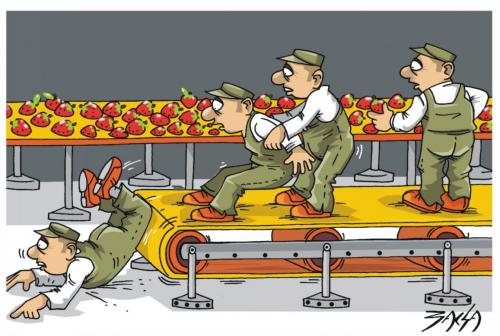SHORT NOTES FROM:
BRING OUT THE BEST
IN EVERY EMPLOYEE
Don Brown and Bill
Hawkins
Mcgraw Hill (200
pages)
INTRODUCTION
 |
| CartoonStock |
Leadership is essentially the
process of:
Influence
Getting someone else to do
something and feel good about it
Bringing out the best in every
employee
A powerful leader’s protocol
will be learning to be present to meet the team’s needs for communication,
feedback, and autonomy. To equip, you
need to know the 5H1H:
What your people want – The Source
Why the need of protocol for
leadership – The Setting
What element that trumps all
others – The x-Factor
What’s in it for everyone – The Return What need to be done –
The Way
How to succeed –
The Fuel
Leading today is very different
from the way it was. A culture of
never-ending change has settled upon us.
The entire world is on a change curve.
That’s why the need for leader’s protocol.
Empathy means that others
believe that you understand and that you care.
Simply understanding, both intellectually and emotionally, and caring
about their circumstances is directly connected to how engaged they become in
performing for you.
The return on bringing out the
best in others is directly correlated with the output of your team. It is about creating capacities without
additional headcount. In order to get
the return, you need to be able to be present.
The fuel for effective
leadership is generating and focusing your passion for what you do as a
leader. There is a lot you can’t control
today in your organizational environment.
But you can control your thoughts, your feelings and your conduct. Be happy and passionate about what you do as
a leader.
A
NEW ERA
 |
| Toonpool |
Change that was once seen as a
well-deserved realignment of an antiquated rust belt or dot-com paradigms now
bleed over. So there is no-normal. Understanding is the first step towards
acceptance and adaptation.
NO-NORMAL VARIABLES
|
|
GROWTH
|
There is a great
deal of growth taking place. Growth no
longer takes the form of simply striving for more of everything.
Growth can mean a
shift in complexity. Growth can be
seen as dynamic movement from one stage or form to another.
In a no-normal
state, growth often means consolidation, organizations still become larger.
A final
manifestation of growth is to increase in efficiency and complexity. The work we have to do is growing. More with less is a very real mantra for
just about everyone.
Aby ‘right-sizing’
of the workforce is a balancing act of capacity with current demand. Our labor force is becoming smaller but more
efficient.
Growth is a
significant part of a no-normal economy.
It’s just a new kind of growth.
It comes in new forms. It
causes jobs to expand, not the workforce.
It demands a significant increase in personal capacity with personal
capacity with a zero increase in headcount.
|
CHANGE
|
Change essentially means ‘to make
different.’ Change has been a huge
part of our professional lives. Two
(2) very important lessons about change in a no-normal world:
i.
It’s an interactive global curve
ii.
It’s an externalization of events
(things happening to us)
The nature of change has morphed
into one everyday occurrence. It’s
also happening outside in. The pace of
change is so rapid that a cumulative effect of change has kicked in.
|
RELATION-SHIPS
|
People are waiting
to be engaged. They are waiting to
give more discretionary performance.
We can get significant increases in capacity without adding numbers.
|
Technology has played the single
largest role in this no-normal era. It
has transformed our very lives. We are
all connected. The general purpose of
software application has been to save time and increase productivity. The development of software was designed to
make our lives easier and more efficient.
This new era has added a new role for technology’s integration into our
lives: entertaining and connecting us.
Organizations have off-loaded
work, in many cases, as a cost-cutting strategy. The integration of hardware and NetWare comes
at a cost. The more we connect
electronically, the less we connect personally.
We are losing the ability to connect with each other.
The important issue here is the
loss of the empathic connection. Empathy
is the direct identification with another person’s situation, feelings, and
motives. Be understanding and sensitive
to the feelings, thoughts, and experiences of another person. The basic connection of understanding and
caring about another human being is a prerequisite to understanding what drives
another person’s intentions and motivations.
With the adoption of rightsizing
as a survival strategy, organization loyalty to the employee became a thing of
the past. The lifelong relationship
between an organization and its employees is gone. Individual loyalty to the employer has also
taken the same hit. Loyalty in any
relationship is always a two way street.
The rule of engagement spells
out the appropriate actions in the course of duties. Engagement matters: how to engage with
employees and how they can engage themselves.
In most circles, employees’ engagement is defined in emotional terms:
How they feel about their boss
The amount of trust and
confidence they have in their leader
A reflection of their emotional
attachment to their work.
Factors
that drives engagement:
Feedback and
dialogue with the boss
The quality of
working relationships
The perception
that a leader lives the organization’s values, not just recites them
To increase the odds of riding
out the perfect storm of leadership:
Hear what your people want you
to know, but have been reluctant to say to you
Receive the best of thousands of
live suggestions on what to do to engage them
Learn how to target your efforts
Master the power of being
present with others, to rescue dying empathy
Take home a protocol for leading
in the moment and finding the energy to do it.
To
be continued….part 2

No comments:
Post a Comment